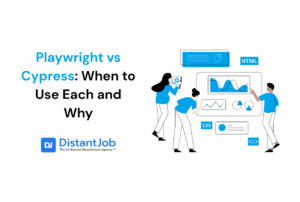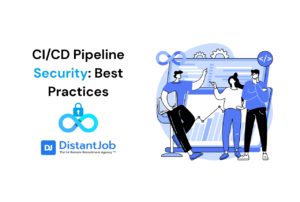Let’s face it: Programming is hard and time-consuming. And the more complex it gets, the slower it becomes. When you have to deploy that feature or release that application on time to market, knowing ways to make your task easier is the best you can do. Here comes low-code and low-code. But which one is better? Which one should you choose from this Low-Code vs. No-Code match? Let’s find out.
Gartner predicted in 2024 that by 2028, 60% of new applications developed by companies would utilize low-code or no-code technologies, and by 2029, that number would rise to 80%. Adopting low-code technologies is even more widespread: 98% of companies, respondents to a Mendix survey, use low-code technologies, and 75% believe low-code improves their organisation’s ability to innovate at scale.
Low-Code and No-Code are rocking software and app development by providing faster, more collaborative, wide-range platforms to every step of the development process.
But first, let us discuss each one of them.
What is Low-Code?
Low-code is a development method that uses as little code as possible to save time. This practice dates back to the fourth generation, created in the 1970s and 1980s. At that time, the situation was a bit different (they used a private programming language). They documented the programming language, so people could just copy and paste chunks of code ready to use. The idea was to save time.
Nowadays, developers use low-code platforms. They noticed many lines of code repeated ad nauseam at every project, but it still had to be added by hand, consuming time and money. A low-code platform provides services that deliver most of these manual tasks already done. It optimizes development time and avoids unnecessary work.
WordPress is an example of such a platform. It provides a free and open-source content management system that lets anyone build and manage websites easily. You won’t need a group of full-stack developers to create a site from scratch, but you still will benefit from them in customization.
That is an important aspect of low-code development: you still code. The service is half-done; it just requires some adjustments.
Pros of Low Coding:
The low-code approach increases development productivity and app reliability, allows the team to focus on features that really matter, and cuts costs (time and money). Moreover, it might provide standardized security mechanisms. Artificial intelligence is a big plus, being adaptable and providing continuous development.
Faster Development
Low-code makes development faster, generating standard code for you. This can reduce development time by orders of magnitude – 451 Research estimates from 50% to 90% for certain applications. By dragging low-code’s pre-built components, developers might assemble apps in days instead of months.
Flexibility and Customization
Low-code lets you write some custom code when needed. It means you can create custom features or work around platform limitations. The result is highly customizable applications that don’t all look or behave the same. You get the best of both worlds: speed from templates and freedom to code for uniqueness.
Integration Capabilities
Low-code platforms provide connectors, APIs, and support for web services out of the box. You may connect a legacy database, use external APIs, or integrate with enterprise systems easily.
Scalability and Company Needs
Using custom code, low-code apps can scale to handle larger user bases and complex logic. Low-code is used to build core business applications in many companies, not just simple departmental tools. Low-code tools support deployment on different environments (cloud or on-premises) and fine-tune performance.
Collaborative Development
Professional developers and other staff can collaborate effectively – business experts contribute using visual models while developers ensure the app meets technical requirements. Low-code works here as a common language between business executives and IT.

Cons of Low-Code:
Low-code can’t do everything. It requires at least some programming and might make you code more than just “Hello World”. And if you code it wrong, bugs erupt as usual.
Requires Some Coding Knowledge
Low-code doesn’t mean 100% code-free. At some point, you might have to code, and it includes a learning curve for non-developers. They are not as immediately approachable to a true beginner as no-code tools.
Potential for Code Issues
Custom codes mean custom bugs or errors. A badly written code snippet might break an app, which means testing and debugging are still necessary. Additionally, any custom code you’ve added might require adjustments every time the low-code platform updates or patches.
Platform Lock-In
Relying on a low-code platform can lead to vendor lock-in. If you switch platforms or revert to manual coding, you may need to code many parts from scratch.
Limited Flexibility vs. Full-Code
While low-code is much more customizable than no-code, building from scratch always wins. The platform’s components might not reproduce your fancy schmancy custom feature. For example, low-code might not give you full control over performance optimizations or low-level system access that traditional development does.
Cost Considerations
Low-code platforms are commercial products with per-user or subscription fees. If you’re at a small startup or all alone, they might drain your budget. In comparison, coding from scratch only costs time (and possibly some open-source tool investments). So, if you have the coding expertise and have no hurry, you might save money by avoiding a low-code licensing fee. Otherwise, development speed often justifies cost in a business setting.
What is No-Code?
If low-code still requires code, no-code goes to the extreme. No-code development doesn’t involve programming. A no-code platform allows anyone to develop applications. Here, you already have all the pieces ready and organized to assemble. However, it’s less open to customization; the result seems to follow a formula. On the brighter side, it is far more intuitive.
Every low-code resource is here, but there is no deviation from the path, no possibility of innovation. If you need an app that anyone can craft, go no-code.
No-code is designed for those who have no programming skills and need fast results with low customization, especially people who can’t understand that joke about “centering a div”. In other words, it cannot be used in every case, or an option for IT veterans.
What are the Pros of No-Code
No-code trades away coding flexibility for simplicity.
No Coding Required
Zero coding needed. Anyone can start building an application. Anyone! People can turn their ideas into working software. I mean, it won’t be an MVP, but a non-programmer may give developers some ideas of what they want. The learning curve is very low, even Granny can make an app.
Very Fast Development and Iteration
No-code is insanely fast. You drag, drop, and configure pre-built elements, so building a basic app can take just a couple of hours. Making changes is also quick, due to a platform’s UI – you can adapt the application on the fly in response to feedback. An MVP is out of the question, but what about a prototype? It’s far better than paper sketches, and it also has some functionality.
Cost Savings on Development
No-code can save companies’ budgets by “failing fast”, especially startups. That means, instead of wasting money on a full MVP, you show a barely functional app and receive user feedback, especially on UI. No-code tools offer a way to build a prototype cheaply and quickly without investing in a full development team at the outset.
Innovation in Business Units
No-code tools generate innovation outside the IT department. A business executive can create their own app and decide what features they can’t do, giving more ideas to the development team.
Prebuilt Best Practices
No-code platforms offer templates and modules with industry best practices (in design, workflow, and compliance). For instance, a no-code form builder makes a form mobile-responsive and accessible. Meanwhile, a no-code database application might come equipped with fundamental security and validation measures by default. Consequently, it is possible to develop dependable applications without needing to grasp all the intricate technical aspects.
Cons of No-Code
No-code platforms offer limited customization, scalability, and integration, potentially leading to vendor lock-in and shadow IT issues. They may not suit complex applications and can hinder developers’ skill growth.
Limited Customization and Features
No-code is limited. You are confined to your platform’s capabilities. No-code tools limit implementation to their available features, which can be problematic for unique or complex requirements, resulting in potentially generic apps that may not fully meet specific needs. You need another approach for your fancy schmancy feature.
Scaling and Performance Constraints
If you are using no-code solutions, think small. Of course, some no-code platforms claim to support enterprise use. I mean, why wouldn’t they? But by the end of the day, they are a quick fix. While scaling up and out, companies hire more people, buy more computers, or other hardware, because scalability isn’t easy.
Integration and Vendor Lock-In
If your platform doesn’t provide an API or a system to integrate your app, you’re out of options. Don’t even think about taking your app somewhere else. Your entire application is built in their environment. Moving to another platform would mean rebuilding from scratch, with code. Finally, if the vendor changes pricing, discontinues a feature, or goes out of business, your app could be at risk.
Shadow IT
No-code enables anyone in your company, from any department, to create an app. But that software cannot be managed by your company’s IT department. That is called Shadow IT. Just imagine it: your company could end up with dozens of small no-code apps handling business data in silos. What about your security or compliance? Data might be duplicated inconsistently across these apps. Your IT teams might have restricted access to fix or maintain them. In regulated industries, this is a serious concern.
Lack of Learning
No-code can be a dead end for those who want to learn how to program. You aren’t practicing anything using no-code. A student must understand how software truly works under the hood. No-code might hide so much complexity that the user doesn’t learn much beyond using that specific platform.
Strict Solution
Not every type of application can be created with no-code. For example, scientific software or performance-critical systems (like a 3D game engine) are beyond no-code’s reach. Traditional coding (or low-code) remains relevant for these scenarios. So no-code is not a silver bullet – it fills a niche but isn’t universal.
Why not make an MVP from no-code?
Well, if you are okay with an app with no customization (and therefore no market differential), go ahead and dive in. Scalability will also be a challenge. Just know that, if you think about versioning to sell more, forget it. You would need to build it from scratch first.
What are the Real-World Examples of Low-Code Platforms
We talked a lot about low-code platforms. So, let’s explore a few real-world platform examples and see what they’re used for:
Mendix
Mendix is an important low-code platform. It allows people to create web/mobile applications through a visual modeler and a library of components, while still enabling custom Java or JavaScript code when needed.
2,039 companies use Mendix to develop internal tools, customer portals, and even core systems faster. Some examples include Siemens, Philips, BMW, Deutsche Telekom, Global Atlantic Financial Group, Victaulic, and Micron Technology.
OutSystems
OutSystems is another important low-code platform. OutSystems originated from Portugal and offers a full-stack development environment with drag-and-drop UI design, business process modeling, and the option to write custom code/scripts for advanced logic.
It supports highly performant, scalable apps and provides built-in capabilities for deployment, monitoring, and DevOps. OutSystems has been used by businesses to modernize legacy systems or build new customer-facing applications (like online banking portals and insurance claim systems), much more quickly, while upholding strict security and UX standards. Mendix and OutSystems are sometimes compared to one another as they operate in the same market.
2,381 companies use OutSystems, including Toyota, Deloitte, Bosch, Western Union, GM Financial, Roche, and InnoTech.
Microsoft Power Apps
Power Apps is a part of Microsoft’s Power Platform. It allows you to create custom business applications with a low-code approach, using a visual editor to support the Microsoft 365 and Azure ecosystems.
Users (typically power users in an organization) can build apps that use data from Office 365, Dynamics CRM, SharePoint, etc. Users will use familiar concepts of a visual editor for layout and an Excel-like formula language for logic.
Because of its low-code capabilities, many companies use Power Apps to quickly create custom forms, applications, or mobile apps that help provide user productivity and additional value in organizations where Microsoft services are already being used.
5,688 companies use Pòwer Apps, including Accenture, SAP SE. Apps Run the World, and 6Sense.
Appian
Appian is a low-code development platform. It specializes in process automation and case management applications, integrating low-code capabilities with Business Process Management (BPM).
3,207 companies use Appian to build applications like incident management systems, customer service dashboards, or compliance tracking tools that involve complex workflows. Appian’s low-code environment lets developers model processes and UI and integrate with other systems. Some examples are Santander, Bits In Glass, and Koniag Government Services.
Salesforce Lightning Platform
Salesforce, known for its CRM, also provides low-code tools for building apps on its platform. Companies create custom interfaces, forms, and business logic using Salesforce’s Lightning App Builder and related low-code tools.
252 companies use Salesforce Lightning Platform, like L’Oreal, EPAM Systems, Coursera, and Cognizant.
As you can see, companies use low-code platforms in many contexts. Low-code solutions allow your team to deliver more with less coding.
What are the Real-World Examples of No-Code Tools
No-code platforms thrive with companies like startups and small businesses. Sometimes, even individual hobby projects. Here are some examples of no-code:
Bubble
Bubble is a no-code platform designed for building web applications. Users create everything from simple landing pages to full-fledged SaaS applications without writing code, just through a visual interface. For example, a startup founder could build a prototype of a marketplace or a social network on Bubble to test the idea, from visual design to workflows.
Bubble handles the hosting, database, and logic through its interface. Their website has many showcases of their success. Examples include: TicketRev, TheHair.App, Playground IEP, GoodCourse, Qoins. ByWord, Cuure, Flexiple, Swap Homes, and Bitbrand.
Zapier
Zapier is all about no-code automation. It lets users connect different web services. For example, a marketing professional might use Zapier to automate lead processing. When a lead fills out a Google Form, it automatically adds their info to a CRM and sends a follow-up email via Mailchimp.
This kind of integration, traditionally done by writing glue code or scripts, can be set up in minutes on Zapier with no code. Examples include Laudable, Vector Media, Poka, Fellow, Otter.ai, Remote, Vendasta, Synthesia, Uniplaces, GG Homes, Okta, SpeakerFlow, and ServiceTitan. BairesDev, Alteos GmbH, Brian Moores Ltd, and eatOS POS Inc. Check their showcases.
Webflow
Webflow is a no-code website builder for designers and marketers who want more than site templates. With Webflow, users can visually design HTML/CSS layouts and interactions.
A user simply drags elements and sets properties, while the tool does all the rest. Agencies and freelancers use it to build lean and custom websites for their clients. Many well-known companies use Webflow, including Michael Kors, Dropbox, and Dell. Look at their case studies.
Airtable
At first glance, Airtable seems like a supercharged spreadsheet. But it’s not your average Excel application. Airtable can function as a no-code database and application back-end — it’s a proper relational database.
Users create databases (which look like spreadsheets) and mix them with some other apps to manage data. For instance, a content calendar or an inventory list. Then, using Airtable’s interfaces or extensions, they can build their own apps on top of that data as well.
Small companies use Airtable to track projects, sales leads, or operations, often replacing what might have otherwise required a custom app. Some notable examples include Apple, Samsung, Deutsche Telekom, and IBM, as well as smaller businesses like D2 Fund. Here are some of their customers’ stories.
Low-Code vs No-Code: Which One Should You Choose?
Choosing between low-code and no-code depends on your needs. Both approaches are great when used correctly. It’s not an either/or decision – sometimes they even complement each other. Here are some guidelines to help you decide:
| Feature | Low-Code | No-Code |
| Target User / Required Skills | Developers, programming students | Anyone with no coding experience |
| Application Complexity & Functionality | Better for complex projects with many custom features | Simple apps or automation |
| Speed of Development | Faster than coding, slower than no-coding | Insanely fast |
| Integration Capabilities | Deep integration with other systems and enterprise databases | Limited integration capabilities |
| Scalability & Long-term Maintenance | Better governance, complexity, and scalability | Very limited on maintenance and scalability, you’re at the mercy of the no-code platform |
| Budget & Resources | Significant licensing costs and maybe a developer team | Minimal costs (free trial tier or a subscription) |
| Customization & Flexibility | More customization, still less than pure coding | Limited customization |
| Use Cases / Best For | Complex internal workflow apps, core products that may evolve | Simple apps, basic automation, custom lead capture forms, MVPs (Minimum Viable Products), departmental tools, and prototyping |
When choosing No-Code
If you are a non-technical user or small business owner who needs a simple app or automation right now, and you have no coding experience, No-Code is likely your best bet.
No-code tools will let you get something quickly without hiring developers or learn programming. For instance, a marketing team needs a custom lead capture form, and a database can be built up in a no-code app in a day.
The caveat is that the solution will be limited in scope. It has limited scalability and flexibility. But if it meets your immediate requirements, no-code gets you there fastest with the least complexity.
When choosing Low-Code
If you need to build a more complex application that requires integration, Low-Code is the best choice. Low-code platforms are more suited for applications that go beyond basic functionality.
For example, you won’t build an internal workflow app that draws data from several companies’ databases and applies custom logic with No-code alone.
Low-code will require some development skills, so you’ll either need a developer on the team or be willing to learn. The payoff is an app that can handle complexity and scale. You will be able to decide on more integrations as well.
Finally, it might involve significant licensing costs, and assume you have at least part-time developers. There is a price to pay for scalable, sustainable development.
Conclusion
In summary, choose no-code for simplicity, speed, and if you lack coding skills. It’s perfect for prototypes, departmental tools, and automating routine tasks.
Choose low-code if you are ambitious. Then you need more power and customizability, especially if you have (or are willing to acquire) some programming capability or a developer team.
Remember, the goal is to use the right amount of code for the job: no-code uses none, low-code uses some, and traditional coding uses it all the way.
But, hey. Maybe you are not sure which one is best for you. Maybe you are stuck, trying to get the right decision. In that case, call me. We will talk about your company or startup. As soon as I get all the information needed, I can tell if you just need a no-code app that is simple and limited, or if you need a low-code app.
And if you need someone to develop your app, we will find the best in the world within two weeks. While everyone else takes more than 50 days, in just two weeks, you will get the best developer that suits your needs and company culture!





